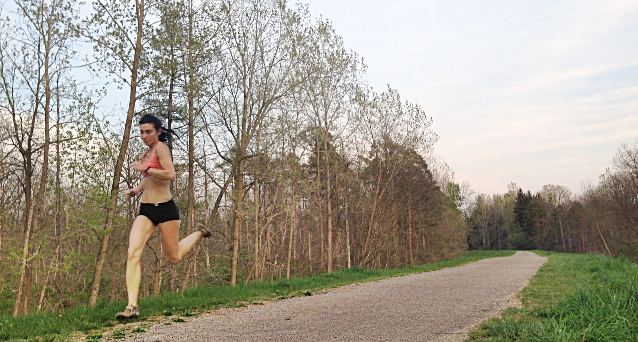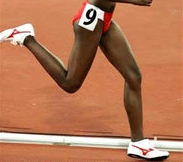I personally think that humans are born to run forefoot, not reafoot, because the mechanics of forefoot running seems to allow the entire body to work in parallel as one big natural shock absorber.

Born to Run Forefoot, not Rearfoot
Optimal shock absorption occurs at the foot strike level in forefoot running whereby the entire body executes reflexive, coordinated efforts to reduce impact peaks. This suggests the human body is more suited to run with a forefoot strike and not a heel strike.
Scientific data demonstrates that everything appears to come together in forefoot running in terms of the shock absorbing mechanisms of the body:
- at foot strike, initial contact with the ground is on the forefoot in a lateral-medial (outer side of foot to the middle) movement pattern which helps eliminate the impact peaks related to heel striking

In forefoot running, foot strike occurs on the balls of the foot in a lateral-medial movement pattern.
- at touchdown, the ankle is close to or under the knee. The ankle then dorsiflexes as the heel drops to the ground allowing for a flat foot placement which reduces jarring
- forefoot running also reduces ankle stiffness which in turn, reduces the ground reaction force
- forefoot running, especially when barefoot, allows for reflexive adjustments in the leg and knee which inhibits shock at touch down
- stride shortens and cadence increases allowing for less force production and loading on the knee and hips
- vertical compliance is higher in forefoot running, resulting in a drop of center of mass and reduces loading
It seems clear that the motions of the body in forefoot running occur in perfect harmony to manage shock. The harmonious impact reducing mechanisms of the body appears to be lost when heel striking whereby distinct impact peaks and other types of forces are greater.
More from Run Forefoot:
Why Older Runners Need to Wear Minimalist Shoes – Find out how minimalist running shoes prevent age-related biomechanical impairments in older runners.
The Cause of ITBS – Understand how running shoes that are stiff and inflexible increases a runner’s risk of ITBS.
Expensive Shoes Doesn’t Mean More Protection – A study found that cheaper running shoes were linked to less injury rates than pricier ones.
Protecting Your Joints – Discover how the best joint protection technique for running is to avoid heel strike.
Born to Run…Forefoot? Here I talk about why humans are anatomically suited for forefoot running, and not heel strike running.
Are Heel Strikers Slower? Here I uncover the 2 main reasons that may slow a heel striker down.
The Neuroscience of Running….Barefoot – An overview of how barefoot running boosts motor coordination patterns in the brain, helping you run with better mechanics.
Shoes for Forefoot Strikers – Read about the barefoot-inspired running shoes that help avoid heel strike.
P.S. Don’t forget to head on over to the Run Forefoot Facebook page, it’s a great place to ask questions about forefoot running vs heel strike running as well as footwear and barefoot running. I’ll be happy to answer them for you!
References:
Lieberman et al., (2010) Foot Strike Patterns and Collision Forces in Habitually Barefoot Versus Shod Runners. Nature,463:531-35.
Samaan et al. (2014). Reduction in Ground Reaction Force Variables with Instructed Barefoot Running. J Sports Health Sci,3(2):143-51.
Bretta Riches
BSc Neurobiology; MSc Biomechanics candidate, ultra minimalist runner & founder of RunForefoot. I was a heel striker, always injured. I was inspired by the great Tirunesh Dibaba to try forefoot running. Now, I'm injury free. This is why I launched Run Forefoot, to advocate the health & performance benefits of forefoot running and to raise awareness on the dangers of heel striking, because the world needs to know.
Latest posts by Bretta Riches (see all)
- Can You Run In Barefoot Shoes? Yes, But DON’T Heel Strike! - 21/07/2024
- Why Cushioned Running Shoes Are Really Bad for Your Feet - 19/07/2024
- Do Cushioned Running Shoes Cause Injuries? - 17/07/2024

Leave a Reply